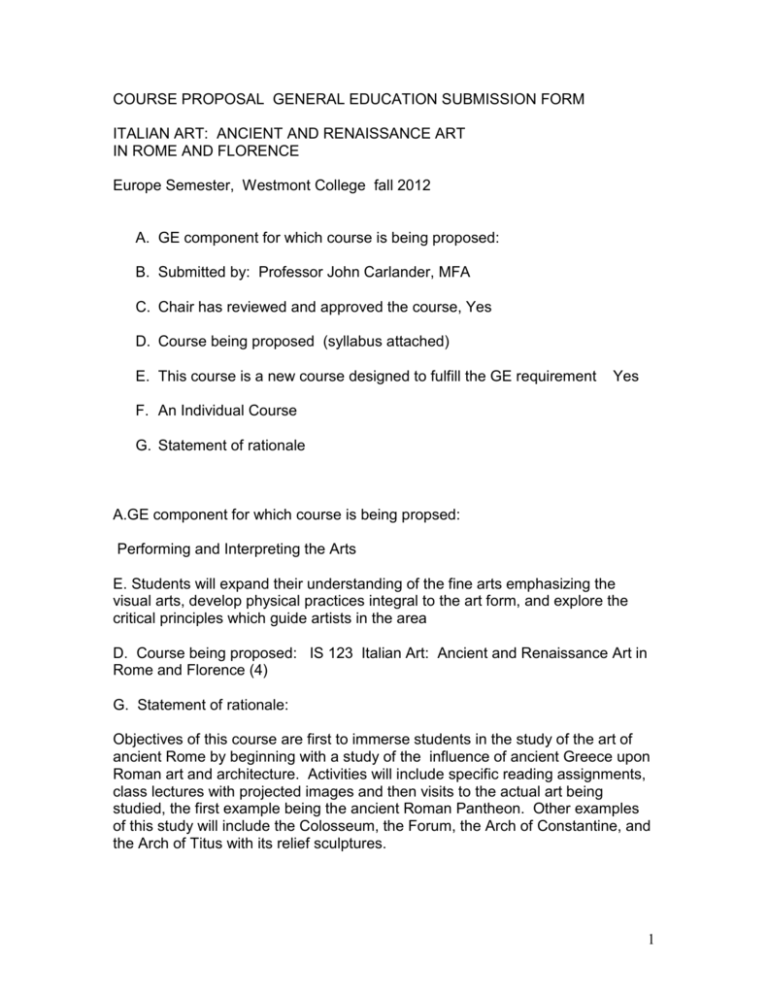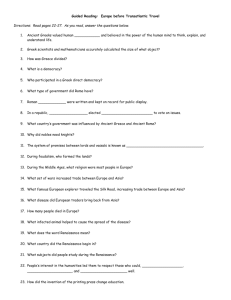My previous sabbatical was spent in Japan where I taught art for a
advertisement

COURSE PROPOSAL GENERAL EDUCATION SUBMISSION FORM ITALIAN ART: ANCIENT AND RENAISSANCE ART IN ROME AND FLORENCE Europe Semester, Westmont College fall 2012 A. GE component for which course is being proposed: B. Submitted by: Professor John Carlander, MFA C. Chair has reviewed and approved the course, Yes D. Course being proposed (syllabus attached) E. This course is a new course designed to fulfill the GE requirement Yes F. An Individual Course G. Statement of rationale A.GE component for which course is being propsed: Performing and Interpreting the Arts E. Students will expand their understanding of the fine arts emphasizing the visual arts, develop physical practices integral to the art form, and explore the critical principles which guide artists in the area D. Course being proposed: IS 123 Italian Art: Ancient and Renaissance Art in Rome and Florence (4) G. Statement of rationale: Objectives of this course are first to immerse students in the study of the art of ancient Rome by beginning with a study of the influence of ancient Greece upon Roman art and architecture. Activities will include specific reading assignments, class lectures with projected images and then visits to the actual art being studied, the first example being the ancient Roman Pantheon. Other examples of this study will include the Colosseum, the Forum, the Arch of Constantine, and the Arch of Titus with its relief sculptures. 1 A second major objective of this course will be a concentration upon the art of the Early and High Renaissance in Italy, particularly focusing upon the art that is accessible in Florence. While in Rome some inclusion of Renaissance works will be included in the course, including the obvious masterpieces St. Peter’s Basilica, the Sistine Chapel, the Stanza della Signatura, the buildings on the Capitoline Hill, and the Moses by Michelangelo. In Florence, painting, sculpture and architecture will all be studied and then each example will be seen in person. The first objective will be to talk in class (lecture and discussion) about the Or San Michele, as it exemplifies the guild system at the time of the Early Renaissance. Since the building is easily accessible, a first walking tour will include it along with the Palazzo Vecchio and the Duomo, (Santa Maria della Fiori). The obvious advantage of this course will be not only the study of these major art works via reading and study of the printed and projected images but visiting them to view the actual artworks will give the students a lasting investigation into the art of the Renaissance and its place in history. This course at the beginning will examine the relationship between ancient Greek art and its heavy impact upon the art of ancient Rome. Comparisons of Greek temples with Roman temples will be examined. The motivations and needs of the Roman Empire will be looked at in terms of their massive building projects, including aqueducts, baths, temples, triumphal arches and public meeting spaces. The Roman expansion of Greek concepts will be observed in such examples as two Greek theatres being brought together to form an amphitheatre, or colosseum. Classroom activities will include preparation for visits to the magnificent ancient Roman structures such as the Pantheon, the Colosseum and the ruins on the Forum, the Arch of Constantine and the Arch of Titus. A visit will be made on the Forum to the Basilica of Maxentius and Constantine and nearby to the the Column of Trajan, and later the Ara Pacis, the Altar of Peace, time permitting. While the emphasis on the Renaissance will be primarily in Florence, major works in Rome from the Renaissance period will also be studied and visited. These include the Capitoline Hill and the buildings there designed by Michelangelo. The statue of Moses will be viewed after classroom discussion, at San Pietro in Vincoli, Rome. A study of St. Peter’s Basilica, the Sistine Chapel, the Stanza della Segnatura in the Vatican Palace and the Moses by Michelangelo In Florence the emphasis will be upon Early Renaissance and High Renaissance art, primarily with painting, sculpture and architecture. Classroom instructional activities regarding architecture will be in lecture and discussion of specific buildings such as the Orsanmichele and the sculptures of the guilds adorning the building, the Palazzo Medici-Riccardi, The Duomo, The Pazzi Chapel, Santa 2 Croce and San Lorenzo. A painting of the Trinity by Masaccio will be first studied in class and then visited at Santa Maria Novella. The important paintings by Masaccio at Santa Maria del Carmine will be viewed after classroom study. At the Monastery of San Marco in Florence, the beautiful painting of the Annunciation by Fra Angelico will be seen, along with the paintings by him in each of the individual monks’ cells. The larger room of Cosimo de’Medici can be entered as well as the cell where Savonarola lived and studied. The Galleria degli Uffizi that contains the world’s greatest collection of Renaissance Painting will be a highlight of the course. The competition between Filippo Brunelleschi and Lorenzo Ghiberti with the subject of the Sacrifice of Isaac can be studied at the Museo Nazionale del Bargello in Florence. Along with those competition panels significant major works by Donatello including the Prophet (Lo Zuccone), originally from the campanile of the Florence Cathedral, and his David and Repentant Magdalene will be studied. The David by Andrea del Verocchio, teacher of Leonardo da Vinci will round out a study of a trio of Davids, those of Donatello, Verocchio and Michelangelo. A major aspect of the course will be the actual production of well-directed studio projects that will be produced by the students themselves. A small kit of art supplies will be given to each student in order for them to experience what it means to design and create art works. Within this process will be exposure not just to Renaissance art in Italy, but also to 20th Century concepts in art that also might spill over into a limited discussion of 20th and 21st Century contemporary art. This connection will help students to understand the art of the Renaissance within the context of the time period in Italy and then the contrast with 20 th Century concepts will engage their imaginations to understand many differences some possible connections. ASSIGNMENTS Students will be given topics for individual reports. An individual will be given a topic such as the Moses by Michelangelo. An oral presentation by the student will be given in class before visiting the church housing the sculpture, Reading from texts and/or a reader will comprise a majority of outside of class work. Art assignments will be given and will be worked on in class as well as outside of class. INSTRUCTIONAL ACTIVITIES Class presentations will be given via LCD projector, projecting the images in the classroom so that lecture can be enhanced by the images and class discussions can be carried out with the assistance of those images. Lectures will concentrate on the specific images and what the students can expect to experience when they see the actual works. The visit to see the actual original work will involve the 3 students after they have learned significant facts about the work and after they understand the later historical impact these works spawned. Teaching techniques will involve asking questions of students after they have read about the period of time. Questions regarding the history of the area at the time, the involvement of the Church in the culture of the day, the tensions of war and politics at the time of the Renaissance, and the response of the artists to some of those pressures, including the pressure of the Pope upon Raphael and Michelangelo to produce work adequate to the desires of the Pope. These questions and many others will involve the students in discussions both with the professor and with each other in discussion groups. REQUIRED READINGS Reading assignments will be given so that students are well-prepared to see the major works Both having knowledge regarding facts and details regarding the works, placing them in historical context and then viewing and studying the images ahead of time will prepare the students for what they are going to see and experience. The particular reading materials are yet to be selected. Explorations are being made regarding putting together a reader or text, also with images, that each student may carry with them. Seeing the images is important to the course, so the books selected or the reader will need to cover the material thoroughly. (Attention is being paid to weight so that the material will not become too heavy to carry from city to city.) TESTS/EXAMS Tests will cover some of the facts of the artists and their art works as well as questions developed from lectures. Questions will be included that allow for students to express individual responses to what they have studied and seen in person, so questions that ask for both objective and subjective responses will a part of the tests and exams given. Informed subjective responses will be encouraged as a way to engage the students’ interest into ways of thinking with which they are not very familiar. Test will include both direct “fill in the blank” questions, identification of much of the art we will have studied, and essay questions probing their understanding of the material beyond the facts. CERTIFICATION CRITERIA Developing language and terminology that identifies art periods and movements, artists’ work and techniques and words commonly used in the description and interpretation of art and art movements will be a necessary component of the course. Practice in speaking about art and writing about art will be developed during the course. 4 Methods of analysis, interpretation and the enjoyment of the art being viewed both in class and in museums will be developed. The involvement of the students with the Christian content of the art plays a large part in understanding it, and through the process of observation and experience the topic of Christian faith evolves as a product of the viewing and class discussions. The Protestant dislike of images and the Roman Catholic love of images confronts the students with a challenge, intellectually, spiritually and personally. In actually making art, students will be given specific methods and it is through their projects that they will express individuality and their own subjective thoughts through their own individual decisions. While the physical processes used during this four week course will not approach the sophistication of art from the Renaissance, in other words, the students will not paint frescoes, carve stone or cast sculptures in bronze, physical processes will involve media that art appropriate to the level of the students and to the physical situation, and those will allow for “artistic realization and production.” Within the limits of traveling in Italy and working in limited spaces, students will demonstrate “appropriate techniques” and will show critical awareness in their artistic productions. TEXTS Texts or readers will be a part of this course and specific texts are still being reviewed at this time. Some of those being considered include: Roman Art and Architecture Mortimer Wheeler Thames and Hudson Art in Renaissance Italy John T. Paoletti & Gary M. Radke Pearson/Prentiss Hall Renaissance Florence A. Richard Turner Prentice Hall The Lives of the Artists Georgio Vasari 5








